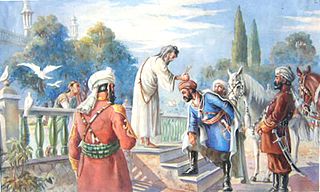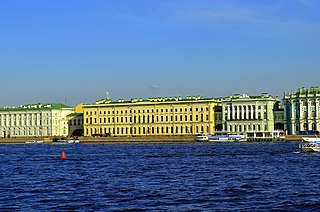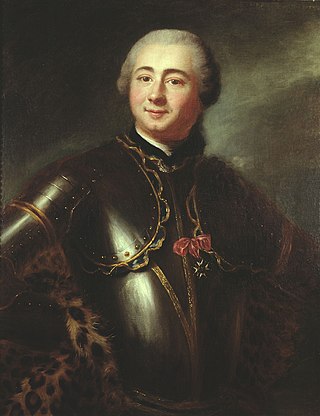
1747 (MDCCXLVII) was a common year starting on Sunday of the Gregorian calendar and a common year starting on Thursday of the Julian calendar, the 1747th year of the Common Era (CE) and Anno Domini (AD) designations, the 747th year of the 2nd millennium, the 47th year of the 18th century, and the 8th year of the 1740s decade. As of the start of 1747, the Gregorian calendar was 11 days ahead of the Julian calendar, which remained in localized use until 1923.

Elizabeth or Elizaveta Petrovna was Empress of Russia from 1741 until her death in 1762. She remains one of the most popular Russian monarchs because of her decision not to execute a single person during her reign, her numerous construction projects, and her strong opposition to Prussian policies.

The State Hermitage Museum is a museum of art and culture in Saint Petersburg, Russia. It was founded in 1764 when Empress Catherine the Great acquired a collection of paintings from the Berlin merchant Johann Ernst Gotzkowsky. The museum celebrates the anniversary of its founding each year on 7 December, Saint Catherine's Day. It has been open to the public since 1852. The Art Newspaper ranked the museum 10th in their list of the most visited art museums, with 2,812,913 visitors in 2022.

Baroque architecture is a highly decorative and theatrical style which appeared in Italy in the late 16th century and gradually spread across Europe. It was originally introduced by the Catholic Church, particularly by the Jesuits, as a means to combat the Reformation and the Protestant church with a new architecture that inspired surprise and awe. It reached its peak in the High Baroque (1625–1675), when it was used in churches and palaces in Italy, Spain, Portugal, France, Bavaria and Austria. In the Late Baroque period (1675–1750), it reached as far as Russia, the Ottoman Empire and the Spanish and Portuguese colonies in Latin America. In about 1730, an even more elaborately decorative variant called Rococo appeared and flourished in Central Europe.

Johann Georg Gmelin was a German naturalist, botanist and geographer.
The year 1826 in science and technology involved some significant events, listed below.

Prince Alexander Andreyevich Bezborodko was the chancellor of the Russian Empire from 1797 to 1799, and the chief architect of Catherine the Great's foreign policy after the death of Nikita Panin.

The 32nd G8 summit was held on 15–17 July 2006 in Saint Petersburg, Russia. The venue was the Constantine Palace, which is located in Strelna on the Gulf of Finland. This was the first time Russia served as host nation for a G8 summit; and the nation's status as a full member of the G8 was confirmed.

Île-Royale was a French colony in North America that existed from 1713 to 1763 as part of the wider colony of Acadia.
Asiamericana is a dubious genus of coelurosaur known only from isolated teeth found in the Bissekty Formation of Uzbekhistan. It was named to recognize the occurrence of similar fossil teeth in Central Asia and North America. These regions once formed a connected land mass, during the Cretaceous period.

Charles Deschamps de Boishébert was a member of the Compagnies Franches de la Marine and was a significant leader of the Acadian militia's resistance to the Expulsion of the Acadians. He settled and tried to protect Acadians refugees along the rivers of New Brunswick. At Beaubears National Park on Beaubears Island, New Brunswick he settled refugee Acadians during the Expulsion of the Acadians.
The Treaty of Saint Petersburg or Treaty of Ili was an unequal treaty between the Russian Empire and the Qing dynasty that was signed in Saint Petersburg, Russia, on 24 February [O.S. 12 February] 1881. It provided for the return to China of the eastern part of the Ili Basin region, also known as Zhetysu, which had been occupied by Russia since 1871 during the Dungan Revolt.

The Battle of Grand Pré, also known as the Battle of Minas and the Grand Pré Massacre, was a battle in the mid-18th century King George's War that took place between New England forces and Canadian, Mi'kmaq and Acadian forces at present-day Grand-Pré, Nova Scotia in the winter of 1747 during the War of the Austrian Succession. The New England forces were contained to Annapolis Royal and wanted to secure the head of the Bay of Fundy. Led by Nicolas Antoine II Coulon de Villiers and Louis de la Corne, Chevalier de la Corne under orders from Jean-Baptiste Nicolas Roch de Ramezay, the French forces surprised and defeated a force of British troops, Massachusetts militia and rangers that were quartered in the village.

The Consulate-General of France in Saint Petersburg is the diplomatic mission of France in Saint Petersburg, Russian Federation. It is located at 15 Moika River Embankment in the Tsentralny District in Saint Petersburg.
The Convention of Saint Petersburg may refer to several diplomatic agreements including

Sir Hugh Cloberry Christian KB was an officer of the Royal Navy who saw service during the American War of Independence, and the French Revolutionary Wars.

Saint Petersburg, formerly known as Petrograd and later Leningrad, is the second-largest city in Russia after Moscow. It is situated on the River Neva, at the head of the Gulf of Finland on the Baltic Sea. The city had a population of 5,601,911 residents as of 2021, with more than 6.4 million people living in the metropolitan area. Saint Petersburg is the fourth-most populous city in Europe, the most populous city on the Baltic Sea, and the world's northernmost city of more than 1 million residents. As the former capital of Imperial Russia, and a historically strategic port, it is governed as a federal city.

Jean Louis Tocqué was a French painter. He specialized in portrait painting.

The Peterhof Palace is a series of palaces and gardens located in Petergof, Saint Petersburg, Russia, commissioned by Peter the Great as a direct response to the Palace of Versailles by Louis XIV of France. Originally intending it in 1709 for country habitation, Peter the Great sought to expand the property as a result of his visit to the French royal court in 1717, inspiring the nickname of "The Russian Versailles". The architect between 1714 and 1728 was Domenico Trezzini, and the style he employed became the foundation for the Petrine Baroque style favored throughout Saint Petersburg. Also in 1714, Jean-Baptiste Alexandre Le Blond, likely chosen due to his previous collaborations with Versailles landscaper André Le Nôtre, designed the gardens. Francesco Bartolomeo Rastrelli completed an expansion from 1747 to 1756 for Elizabeth of Russia. The palace-ensemble along with the city center is recognized as a UNESCO World Heritage Site.

Count Pyotr Grigoryevich Chernyshev was a Russian Imperial nobleman, diplomat, privy counsellor, chamberlain, and senator.